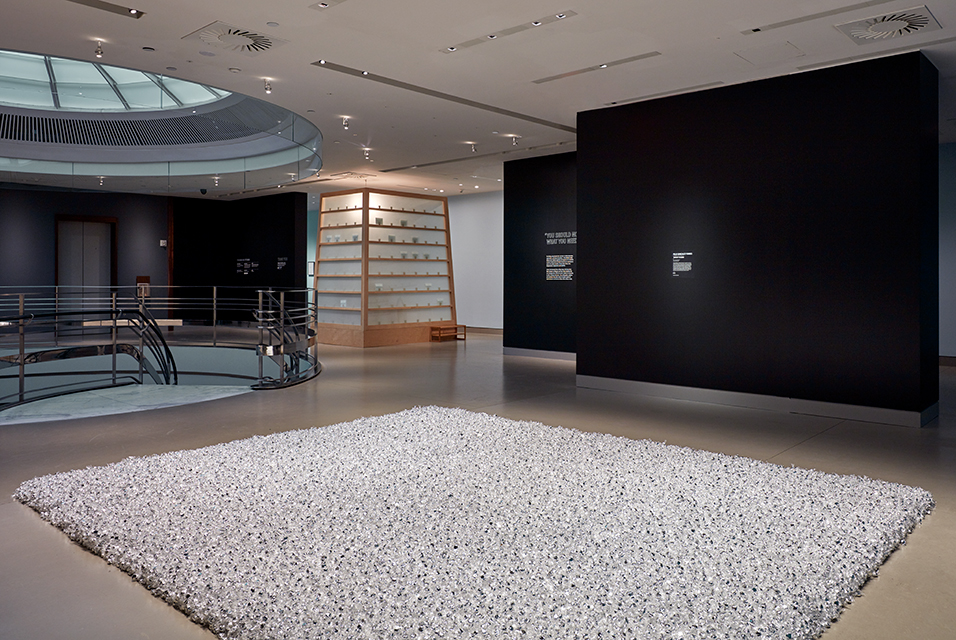Measure Your Existence, a group exhibition about impermanence opens at the Rubin Museum

Artdaily_NEW YORK, NY.- Measure Your Existence,” a new group show organized by guest curator of contemporary art, Christine Starkman is on view at the Rubin Museum. The exhibition features six contemporary artists who address the fleeting nature of existence through performance, installation, film, sculpture, and photography. The artists interrogate the transitory nature of fate, relationships, borders, and more, and in doing so call attention to the importance and inherent power of the present moment. The exhibition is part of the Rubin Museum’s yearlong thematic exploration of impermanence and accepting change, a fundamental principle in Buddhist philosophy. “Measure Your Existence” is on view from February 7 to August 10, 2020, and feature works by Felix Gonzalez-Torres, Shilpa Gupta, Tehching Hsieh, Meiro Koizumi, Lee Mingwei, and Taryn Simon.
The artists in “Measure Your Existence” come from a broad range of philosophical and theoretical backgrounds, and collectively their work spans five decades, yet they all respond to history, change, duration, memory, loss, disappearance and reappearance. Felix Gonzalez-Torres’s “Untitled” (Placebo) (1991) has an ideal weight of 1,200 pounds. In this manifestation of the work, silver-wrapped hard candies are arranged as a large carpet on the gallery floor. Visitors can choose to take individual pieces of candy, making them active participants in the physical form that the work takes in this particular exhibition. While the candies will dwindle as individuals take from the work, the exhibitor can replenish the candies as they see fit. “Untitled” (Placebo) can be understood as a means of registering the poetic boundaries between public and private, art and life, and the transitory nature of each moment. Similarly, ephemera and documentation from Tehching Hsieh’s “One Year Performance” (1980–81) highlight the passage of time and the disappearance of the self, as for a full year the artist marked every hour by punching a timecard in his studio. Hsieh documented the performance by taking a self-portrait next to the time clock at each hour.
Participation is at the heart of Lee Mingwei’s “The Letter Writing Project” (1998), which invites visitors to enter a booth and write letters of remembrance to a deceased or absent loved one, or write letters of forgiveness and gratitude. The work reflects on trust, the exchange of unspoken words, and the possibility of making amends. In Taryn Simon’s photographic and textual project “A Living Man Declared Dead and Other Chapters I–IVIII” (2008–11), the external forces of territory, power, circumstance, and religion collide with the internal forces of psychological and physical inheritance. The work considers the fragile nature of survival, mapping the relationships among chance, blood, and other components of fate.
The disappearance of people and places haunts Shilpa Gupta’s “1:14:19 / 1188.5 Miles of Fenced Border — West, North-West / Data Update: Dec 31, 2007” (2011–12). When multiplied by the ratio in the title, the length of the white thread wound into a large ovalshaped object equals that of the fenced border between India and Pakistan. The static and poetic form of the artwork stands in contrast to the disputed, volatile border where national and social identifications shift and are reinforced. Reality and fiction also blend in Meiro Koizumi’s “My Voice Would Reach You” (2009). To create the video, Koizumi asked an actor to write a letter to his deceased mother, which Koizumi then turned into a script for the actor to follow when randomly calling Japanese companies and inviting his mother out for the weekend. The ensuing conversations captured on film document the actor’s deep, moving emotions of loss and grief.
“‘Measure Your Existence’ invites the viewer to experience the concept of impermanence through participation, co-creation, and reflecting on change, duration, and disappearance,” says guest curator Christine Starkman. “The artists make us aware of ourselves sensing the flow of time and change. Materiality is also at the heart of this show.”
As part of the exhibition, artist Lee Mingwei will give a Brainwave talk exploring the mechanics of grief on Saturday, February 29, at the Rubin Museum of Art.
In 2020 the Rubin’s exhibitions, programs, and experiences are unified in exploring the concept of impermanence. Drawing on a diverse range of sources and perspectives — from contemporary art to scientific theories to Buddhist philosophies — the Rubin explores the freedom and ease that comes from letting go of expectations and consciously living in the present.
